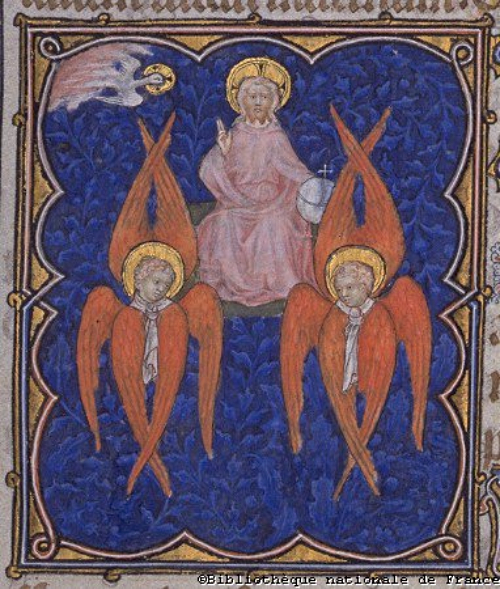In the Bible, the term "Seraphim" refers to a type of celestial being or angelic creature that is described in the book of Isaiah, specifically in Isaiah 6. This passage is a vision that the prophet Isaiah had of the throne room of God, and it provides a glimpse into the heavenly realm:
The prophet Isaiah tells us that the seraphim are six-winged “fiery” angels who surround God as He sits upon His exalted throne and who worship God continually (Isaiah 6). The seraphim also minister to the Lord and serve as His agents of purification, as demonstrated by their cleansing of Isaiah’s sins before he began his prophetic ministry.
"1 In the year that King Uzziah died, I saw the Lord, high and exalted, seated on a throne; and the train of his robe filled the temple. 2 Above him were seraphim, each with six wings: With two wings they covered their faces, with two they covered their feet, and with two they were flying. 3 And they were calling to one another: 'Holy, holy, holy is the Lord Almighty; the whole earth is full of his glory.'" (Isaiah 6:1-3)
From this description, we learn that Seraphim have six wings, and their primary role is to praise and worship God. They are known for their proclamation of God's holiness with the repeated cry of "Holy, holy, holy is the Lord Almighty." The imagery of the Seraphim in Isaiah's vision emphasizes the transcendence and majesty of God.
Seraphim are not as frequently mentioned in the Bible as other angelic beings, such as cherubim or archangels, and their role is primarily associated with worship and exaltation of God. The term "Seraphim" comes from the Hebrew word "seraph," which means "burning ones" or "fiery ones," possibly suggesting a radiant or intense nature.
4 Things to Know about Seraphim Angels in the Bible
1. The word “Seraphim” in the Bible appears only in Isaiah 6.
Isaiah chapter 6 is the only passage in the Bible that specifically mentions the word “seraphim,” meaning “the fiery ones.” In that Biblical chapter, Isaiah describes his intense vision of God’s heavenly court. Namely, the prophet saw God seated on an exalted throne surrounded by flying angels called the “seraphim” (Isaiah 6:1-2).
The word “seraphim” is the plural form of the Hebrew root word “saraph,” which means “to burn.” The implication here is that these attendant angels burn with love for God. The seraphim seem to bear a resemblance to humans, as Isaiah describes them as having faces, feet, hands, and voices (Isaiah 6:2-7).
2. The Seraphim are fiery angels who revere God and proclaim His supreme glory.
The seraphim repeatedly proclaim God’s supreme holiness and glory in Isaiah's vision. (Isaiah 6:3). The seraphim do not address God directly but call out to each other in God’s presence: “And they were calling to one another: ‘Holy, holy, holy is the LORD Almighty; the whole earth is full of his glory.’” (Isaiah 6:3).
To be “holy” means being set apart and considered sacred. This thrice invocation of the word “holy” to describe God’s sacred nature appears only two times in the Bible, and angels speak both times to someone transported in a vision to the throne of God.
(The other passage containing this thrice invocation of God’s holiness is found in Revelation 4:8, which also refers to six-winged angels surrounding God’s heavenly throne and constantly declaring God’s glory.)
3. The Trisagion—the thrice invocation of “Holy”—Significance in the Seraphim’s worship of God
The fact that the seraphim in Isaiah’s vision use a three-fold repetition of God’s holiness—called the trihagion—is significant. In ancient Judaism, the number “three” signified completeness and stability, here connoting God’s wholeness as the beginning, the middle, and the end. Announcing God’s holiness three times also connotes:
- God’s eternal nature, which is the same yesterday, today, and forever (Hebrews 13:8);
- God’s divine perfection as seen in the Holy Trinity: the Father, the Son, and the Holy Spirit; and
- God’s complete and supreme holiness is unmatched by anything or anyone else.
Isaiah goes on to describe the effect of the seraphim’s proclamation, telling us that at the sound of the angel’s voices asserting God’s magnificence, “the doorposts and thresholds shook, and the temple was filled with smoke” (Isaiah 6:4). In Biblical times, earthquakes and smoke were signs of God’s divine presence. (Exodus 19:18; Psalm 104:32).
4. The Seraphim also minister to God and serve as His agents of purification.
When Isaiah noticed that the heavenly seraphim covered themselves before God to acknowledge their unworthiness before the Lord, the prophet became aware of his own mortal sinfulness and feared for his life. At that point, one of the seraphim picked up a burning coal “with tongs from the altar,” brought the live coal to Isaiah, and touched it to Isaiah’s lips. (Isaiah 6:6-7). This act purified Isaiah’s sins by fire, as the seraph assured Isaiah that now his “guilt is taken away and [his] sin atoned for.” (Isaiah 6:7).
With his sins cleansed, Isaiah could now speak directly to God. When God called out for a prophet— “Whom shall I send? And who will go for us?”—the “purified” Isaiah was able to accept this prophetic commission to the people of Israel by responding— “Here am I. Send me!” (Isaiah 6:8).
Seraphim Wings: Their Meaning and Significance
Each seraph is described as having six wings: two wings used to cover their face, two used to cover their feet, and the remaining two used to fly.
Two Wings to Cover Their Faces
One reason the seraphim may use four of their six wings to cover themselves is to express their humility before God. In particular, these burning angels may use a pair of wings to cover their faces to show God reverence, considering themselves unworthy to look upon the face of God and also in obedience to the Lord’s admonition that no one may see His face and live (Exodus 33:20).
Two Wings to Cover Their Feet
The fact that the seraphim also use a second pair of wings to cover their feet may further display reverence for God in that the angels may be refusing to reveal any unclean aspects of their being before the Lord.
Two Wings to Fly
The seraphim use their remaining two wings to fly and wait upon God. This detail Isaiah gives us of the seraphim using the majority of their six wings to venerate God and the remaining two wings to serve God may signify that we, as the faithful, serve God best when we venerate Him as our top priority.
Seraphim Bible Definition and Meaning
According to Easton's Bible Dictionary, the seraphim are mentioned in Isaiah 6:2, Isaiah 6:3, Isaiah 6:6 Isaiah 6:7. This word means fiery ones, in allusion, as is supposed, to their burning love. They are represented as "standing" above the King as he sat upon his throne, ready at once to minister unto him. Their form appears to have been human, with the addition of wings. (See ANGELS.) This word, in the original, is used elsewhere only of the "fiery serpents" (Numbers 21:6, Numbers 21:8; Deuteronomy 8:15; Compare Isaiah 14:29; 30:6) sent by God as his instruments to inflict on the people the righteous penalty of sin.
Seraphim is a plural word occurring only in Isaiah 6:2--Isaiah's vision of Yahweh. The origin of the term in Hebrew is uncertain. Saraph in Numbers 21:6, Isaiah 14:29, etc., signifies a fiery serpent. A Babylonian name for the fire-god, Nergal, was Sharrapu. In Egypt, there have been found eagle-lion-shaped figures guarding a grave, to which is applied the name seref. The equivalent English term is "griffin."
It is probable enough that popular mythology connected fire with the attendants of the deity in various ways among different peoples and that burning lies at the base of the idea in all these suggested etymologies. It remains, however, that in Isaiah's use, there is nothing of the popular legend or superstition. These seraphim are august beings whose forms are not at all fully described. They had faces, feet, hands, and wings. The six wings, in three pairs, covered their faces and feet in humility and reverence and were used to sustain them in their positions around the throne of Yahweh. One of them is the agent for burning (with a coal off the altar, not with his own power or person) the sin from the lips of the prophet.
Seraphim are in Jewish theology connected with cherubim and ophanim as the three highest orders of attendants on Yahweh and are superior to the angels, who are messengers sent on various errands. As the cherubim in popular fancy were represented by the storm clouds, so the seraphim were by the serpentine flashes of the lightning, but none of this appears in Isaiah's vision.
In the New Testament, the only possible equivalent is in "the living ones" ("beasts" of the King James Version) in Revelation 4; 5, etc. Here, as in Isaiah, they appear nearest Yahweh's throne, supreme in praise of His holiness. (Excerpt from the International Standard Bible Encyclopedia)
Paintings of the Seraphim

Fresco of the Seraphim in Hagia Sophia by Christophe Meneboeuf

Seraphim - Jean de Berry
Sources:
- Biblestudytools.com, New International Version.
- Biblestudytools.com, Easton’s Bible Dictionary’s definition of “seraphim.”
- Biblehub.com, Hebrew definition of “saraph.”
- Crosswalk.com, What it Means to be “Holy for I Am Holy” – Bible Study Minute – February 1, 2019, Aretha Grant.
- Myjewishlearning.com, Judaism and Numbers, Rabbi Geoffrey Dennis.
Dolores Smyth’s work has appeared in numerous parenting and faith publications. A perfect day for her includes running, reading, and spending time with her husband and three kids. You can find her on Twitter @LolaWordSmyth.
Further Reading:
How Do We Know That Angels Are Real?
What is a Cherub? The Cherubim in the Bible
What Do Biblically Accurate Angels Really Look Like?
Who Are the Four Living Creatures in Revelation?
A Guide to the Archangels: Their Names and Purpose
Photo Credit: © Getty Images/Zwiebackesser; Seraph. (2023, October 25). In Wikipedia. https://en.wikipedia.org/wiki/Seraph









